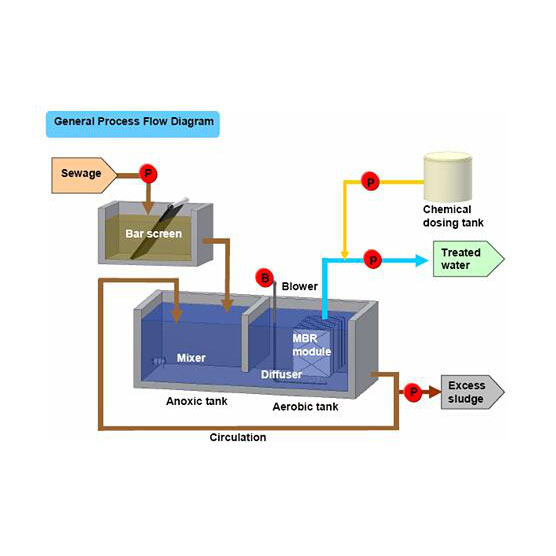Sewage treatment is the process of removing pollutants from municipal wastewater, mainly including domestic sewage and some industrial wastewater. Physical, chemical, and biological processes are used to remove pollutants and produce treated wastewater that is sufficient to be safely discharged into the environment. Several wastewater treatment technologies are available today. We will focus on a widely used sewage treatment process - the sewage treatment plant using MBR technology.
Let us first ask a basic question:
What Is the MBR Sewage Treatment Plant?
MBR sewage treatment plant is an innovative sewage treatment method. MBR, the abbreviation of “membrane bioreactor”, is the core part of the MBR sewage treatment process. It is a combination of a membrane process (such as microfiltration or ultrafiltration) and a suspension growth bioreactor. The hydraulic retention time (HRT) and sludge retention time (SRT) can be controlled individually, and refractory organics are trapped by MBR membrane and constantly decomposed.
Now let us take up the working principle of the MBR wastewater treatment plant.
How Does Membrane Bioreactor Plant Work?
As mentioned earlier, membrane bioreactor wastewater treatment combines conventional biological processes, namely activated sludge, with membrane filtration technology. It can be said that the working principle of the membrane bioreactor is a clever combination of membrane technology and biological treatment.
In an MBR technology system, semi-permeable membranes of two-dimensional materials (microfiltration and ultrafiltration) are immersed in an aerated bioreactor. This degree of filtration allows high-quality sewage to be drawn through the membrane. It also helps eliminate sedimentation and filtration processes commonly used in wastewater treatment. Because precipitation is not required, biological processes can be operated more efficiently. Before the waste enters the membrane tank, it needs to be carefully screened or pretreated. It helps protect the membrane and extend its life by minimizing the accumulation of solid waste.

Features of the MBR Sewage Treatment Plant
The main features of our MBR sewage treatment plant are as follows:
1. This plant produces high-quality treated outlet water: The treated water is completely divided from suspended solids, colloidal materials, and microbial flora. The turbidity and TSS are close to 0. The plant is an affordable and reliable wastewater treatment equipment and can be chiefly used as a pretreatment procedure to eliminate suspended solids.
2. The plant has small foot print and saves land: It uses higher MLSS (Mixed Liquid Suspended Solids) at a concentration of 5000-10000 mg/l. It can attain exactly the exact same loading speed with smaller reactor volume. It does not require a sedimentation tank. Compared to traditional wastewater treatment plants, it requires only a third of the land.
3. The plant saves operating costs and expands the application scope of recycled water: MBR wastewater treatment system can filter out bacteria, viruses and other harmful substances. This significantly saves long-term operation expenses caused by stoichiometry and disinfection and expands the reuse application scope of the purified water.
4. This plant has stable running performance and flexible control: The efficient membrane separation function perfectly captures macromolecular organics and retains them in the system. Therefore, the system can completely realize the separation of hydraulic retention time (HRT) and sludge retention time (SRT), which means that the system runs stably and is flexible to control.
5. The plant has strong shock resistance: MBR membrane can prevent loss of different microbial flora. It’s much beneficial for slow-growing bacteria, such as nitrifying bacteria. The extended residence time is very helpful for the decomposition and degradation of difficult-to-degrade macromolecular organics. MBR wastewater treatment plant is strongly resistant to changes in water quality and water volume.
6. The plant minimizes sludge amount and lowers sludge disposal costs: Using high MLSS, this plant only generates very only generate very a little excess sludge during system operation, thus requiring low sludge disposal costs.
Applications of MBR Sewage Treatment Plant
The MBR sewage treatment plant is suitable for many applications. The followings are some examples:
1.Wastewater treatment and reuse for office buildings, residential community, hospitals, hotels, schools, stadiums, etc.
2.Wastewater treatment for areas where without drainage network system, like tourism scenic spots, resorts, villas, hotels, residential areas, railway stations, toll stations, temporary construction sites, etc.
3.High concentration organic wastewater treatment for mining industry, food industry, pharmaceutical industry, sugar industry, alcohol industry, leather industry, paper industry, printing and dyeing industry, etc.
We, Jinwantong, are one of the most professional and reliable MBR sewage treatment plant suppliers in China. As an ISO9001-certified manufacturer, we provide high-quality, cost-effective, and dependable water treatment solutions and equipment for domestic and foreign customers. You can count on our 14 years of experience in the field.
If you have any questions about MBR sewage treatment system, please contact us. We will help you by giving you the best solution.

